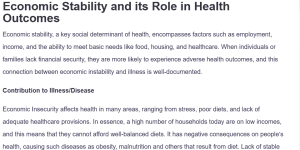Economic Stability and its Role in Health Outcomes
Economic stability, a key social determinant of health, encompasses factors such as employment, income, and the ability to meet basic needs like food, housing, and healthcare. When individuals or families lack financial security, they are more likely to experience adverse health outcomes, and this connection between economic instability and illness is well-documented.
Contribution to Illness/Disease
Economic Insecurity affects health in many areas, ranging from stress, poor diets, and lack of adequate healthcare provisions. In essence, a high number of households today are on low incomes, and this means that they cannot afford well-balanced diets. It has negative consequences on people’s health, causing such diseases as obesity, malnutrition and others that result from diet. Lack of stable employment also exacerbates stress levels, contributing to both mental health disorders such as anxiety and depression and physical conditions like high blood pressure and cardiovascular disease (Nguyen and Drees 92). Moreover, individuals with economic instability may delay or forgo medical care due to costs, resulting in the progression of untreated illnesses, worsened health outcomes, and greater financial strain due to costly emergency care.
The effects of economic instability extend to children as well. Children in financially unstable households are more likely to suffer from developmental delays, mental health issues, and reduced access to preventive care, all of which can have long-lasting impacts on their health and quality of life.
Possible Solutions
Stabilizing the economy requires interventions at a policy level as well as interventions in communities. Policymakers should aim to increase the number of well-paid opportunities and better and cheaper health care and shelters. Economic stability can be controlled by programs designed to provide families with jobs, cash, and shelter. Expanding the social protection systems like unemployment insurance and food subsidies can also decrease the injurious health effects of financial risk (Hardy et al.102). At the community level, basic financial literacy programs and affordable childcare services will assist people in adopting healthy habits, lowering stress, and implying better health. Such integrated forms of practice can help go to the heart of handling health inequalities caused by poverty and economic fluctuations.
Works Cited
Hardy, Bradley, et al. “Strengthening Social Programs to Promote Economic Stability during Childhood.” Social Policy Report, vol. 32, no. 2, Aug. 2019, pp. 1–36, https://doi.org/10.1002/sop2.4.
Nguyen, Bong, and Betty M. Drees. “Food and Nutrition Security in Clinical Settings.” Missouri Medicine, vol. 119, no. 2, 2022, pp. 167–72, www.ncbi.nlm.nih.gov/pmc/articles/PMC9339388/.
ORDER A PLAGIARISM-FREE PAPER HERE
We’ll write everything from scratch
Question
Discussion 3
There are five types of social determinants:
- Economic Stability.
- Education Access and Quality.
- Health Care Access and Quality.
- Neighborhood and Built Environment.
- Social and Community Context.
Economic Stability and its Role in Health Outcomes
Pick one social determinant and explain in thorough detail how it contributes to the development of illness / disease and possible solutions to better the determinant.


